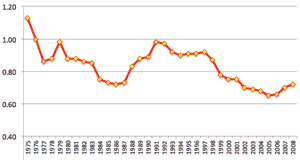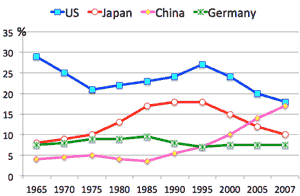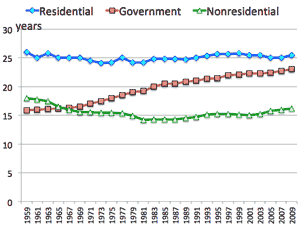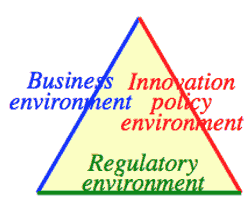>Top 2. Explaining US Economic Decline:
- Why US financial collapse happen?: 1) usual financial crisis, 2) more akin to the Great Depression, 3) an inflection point in US economic history.
- Wall Street has focused on maximizing short-term profits, its excess of greed well chronicled The Bonfire of the Vanities.
- CDOs (Collateralized Debt Obligation, not chief destruction officer); made it hard for investors to understand what they were investing in.
- Capitalized consumption and investment are fundamentally different.: the former doesn't produce future value, while the latter makes poorer today in the hope of becoming richer tomorrow.
- >Top Why dis housing appear to be such an attractive investment?
- the demand for capital from the investment side of the economy shrank while the supply of capital (especially from China) surged.
- 1995-2000: annual corporate investment increased by 537B(73147B (49%)
- 200-2005: corporate investment increased by just $192B (17%), while spending on housing increase 82%.
- Decline in capital investment (manufacturing cap ex): Motor vehicles declined 40%; paper 44%; furniture 53%, apparel 69%; even computer & electronics 49%; electrical equipment & appliances 35%.
- US manufacturers were investing in overseas: GNP increased 9% in 2000-2009, decreasing nearly 50% in domestic.
- Corporate R&D (1999-2006): US 3%, De 11%, Jp 27%, Fi 28%, Kr 58%, Sp 66%, Hu 90%, Cn 187%.
- By 2008, six largest US banks' assets equaled 60% of US GDP, significantly more than before the great panic of 1929.
- >Top US trade deficit exploded from 120Btomid1990stoaround600B a year by mid 2000s.; this meant that large amount of capital flow back into US financial markets.
- The Federal Reserve kept interest rates too low for too long.
- Oversupply of money pushed commercial real estate on the edge.; expansion of the trade deficit almost perfectly matched expansion in spending on housing. (next sucker; Ponzi scheme)
- Wall Street; Main Street (millions of SMB); Manufacturing Street; Research Park Street; and Office Complex Street.
- the problem is that in recent years, US has not been as attractive a place in which to make investments in innovation.
- The Big Short: Wall Street did because most of them believed these were good investment.
- Housing prices: 1987-2000 were actually fairly stable; but after 2001 prices accelerated. (expanding bubble)
- In 2005, Ben Bernanke, chairman of Federal Reserve stated that rising home prices "largely reflect strong economic fundamentals."
- The fundamental mistake was that economists, bankers, and policymakers did not believe housing prices would go down. (Black swan: past performance is not a guarantee of future performance.); Markets might misprice assets.
- America's long-term structural economic decline:
- This decline has two underlying causes:
- 1) deterioration domestically of fundamental sources of US competitiveness, from decaying industries and infrastructure to an erosion of US innovation capacity.
- 2) foreign countries are competing more fiercely and strategically than ever to attain the standards of living.; rebalancing of global economic activity
- US global GDP share 46% in 1946 to 24% in 2009
- deterioration of US innovation capacity is evidenced by underinvestment in R&D, education system, math (STEM) field; a decaying physical infrastructure.
- US has already lost a range of high-tech industries, from PCs to LCDs, batteries, CFL (compact fluorescent lightbulbs); moreover, AI , biotechnology, nanotechnology, robotics, energy storage, and clean energy production.
- Decline in US manufacturing employment: 18M in 1989→11.7M in 2011 (Rust nation debâcle)
- Capacity utilization US factories is nearly as low as it has been in any period since WWII.
- In 2011, US ceded its tile as the world's leading manufacturer since 1900 to China.
- Litigiousness of US:
- Legal services grew at just 36% the rate of overall GDP growth.
- ICT industries:
- Computer systems services grew 17 times faster than the rate of GDP growth.
- Information processing grew 12 times faster.
- But other fast-growing sectors contributed less real value to the economy.
- Financial vehicles:
- the ration of banking profits to manufacturing profits was generally 20% until late 1970s, after that it grew rapidly to 60% in 1990s, reaching 317% in 2002.
- >Top Manufacturing industries:
- Since 1980, a different picture has emerged; the change from that peak year to 2009.
- the capital stock of primary metals industry (steel, aluminum) peaked 1981, and has fallen by 27% since.
- Other industries peaked later, but saw a similarly steep fall in capital stock.
- US was losing employment in lobor-intensive, low-tech manufacturing industries; but US manufacturing sector was not restructuring, it was declining.
- throughout 1980s, Asian players came to dominate production of cassette players, stereos, video recorders, TVs, digital cameras; 80% of machine tools (5 axis machine tools, the most sophisticated) were imported from Jp and De.
- Rate of change of fixed assets by industry: > Fig.
- US decline and Cn rise in global manufacturing: >Fig.
- >Top The same story holds for the next generation of clean energy products.
- Chinese share of photovoltaics market grew 5% in 2000 to more than 50% in 2011, including no-interest loans, free electricity, free land for factories, and other incentives.
- China became the world leader of solar panels in 2009, and wind turbines in 2010, and intends to become leader of lithium batteries between 2015-2020.
- In 2009-2013, China, Japan, & Korea will invest three times more than US in clean technology; investing total 509B,whileUSinvests172B.
- US trade balances for manufactured, nonmanufactured, and advanced technology products, 1989-2011: > Fig.
- What does US manufacture and export these days?
- Wastepaper and scrap metal: the largest US exporter via ocean container in 2007 was not even an US company but Chinese.
- 1872 book chronicled the economy of ancient Rome: carrying to Rome the silks, spices of the East, marble of Asia Minor, timber of Atlas, grain of Africa and Egypt; and no return cargo but dungs.
- US has had a positive trade balance in services; which is smaller than manufactured goods.
- >Top Information Technology and Innovation Foundation (ITIF) report 2011:
- The Atlantic Century II: benchmarked 44 nations on 16 core indicators of innovation-based capacity.
- Indicators include: higher education, researchers per capita, levels of R&D, entrepreneurship, corporate tax levels, and ease of doing business, per capita GDP growth, FDI, productivity, and trade balances.
- Ranking: Singapore #1, Finland, Sweden, US, Korea ... UK, Canada, Denmark, Holland, and Japan.; In ten short years, US lost its top perch.
- dramatic erosion of US innovation capacity during 2000s.
- Rate of change ranking: China #1;
- particularly in four categories; R&D intensity; shares of scientific publications and scientific researchers; patenting activity; number of bachelors, graduates and doctorates in STEM fields (Science, Technology, Engineering, and Math).
- increasing number of master and PhD in STEM fields; 3/4 of electrical engineering and 2/3 of industrial engineering doctorates are awarded to foreign students.
|
2.
米国経済衰退の説明:
- inflection/inflexion: 屈折、変曲 <L. inflectere, bend in
- bonfire of the vanities: 虚栄の篝火
- fraudulent: 詐欺的な <L. fraud, deceipt
- cap ex:<capital expenditure資本支出
- rev, revving: 回転速度を上げる <revolution
- hefty: large & heavy べらぼうな
- surfeit: 過度・過剰な
<L. super+facere, do
- glut: 供給過剰 <F. gluttire, swallow
- faulty: 欠陥のある
- culprit: 犯罪者; 問題の原因
<culpa, fault
- sucker: 騙されやすい人, カモ
- edifice: 大建造物, 組織・体系
- astute: 洞察力のある, 目先が利く
<L. astus, craft
- oblivious: 無頓着で; <oblivision
<L. oblivio, forget
- across the board: 全面的な, おしなべて
- avert: 避ける, そむける
- debacle: 暴落 <L. de+bâcler, bar
- bellyache: 腹痛
- litigious: 論争好きな
- perch: とまり木
|
- なぜWall Streetは近視眼的投資を行ったのか (The Big Short)
- Rate of change of fixed assests by industry:
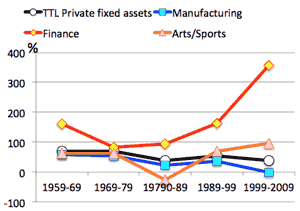
- US decline and Cn rise in global manufacturing:
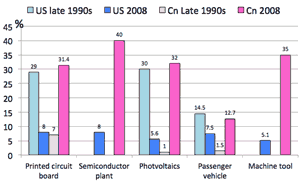
- US Trade balances for manufactured, non-manufadctured and advanced technology product (1989-2011):
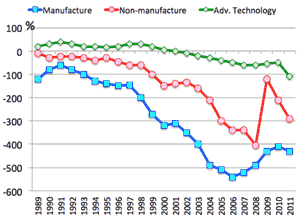
|



